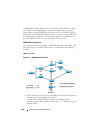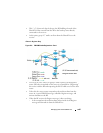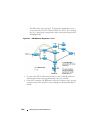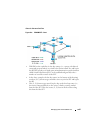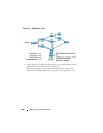
Managing IPv4 and IPv6 Multicast 1341
For more information about when to use PIM-DM, see "Using PIM-DM as
the Multicast Routing Protocol" on page 1352. For more information about
when to use PIM-SM, see "Using PIM-SM as the Multicast Routing Protocol"
on page 1343. For more information about when to configure DVMRP, see
"Using DVMRP as the Multicast Routing Protocol" on page 1354. Unless
specifically required, IGMP/MLD snooping should be disabled on L3
multicast routers.
What Is the Multicast Routing Table?
Multicast capable/enabled routers forward multicast packets based on the
routes in the Multicast Routing Information Base (MRIB). These routes are
created in the MRIB during the process of building multicast distribution
trees by the Multicast Protocols running on the router. Different IP Multicast
routing protocols use different techniques to construct these multicast
distribution trees.
What Is IGMP?
The Internet Group Management Protocol (IGMP) is used by IPv4 systems
(hosts, L3 switches, and routers) to report their IP multicast group
memberships to any neighboring multicast routers. The Dell Networking
N2000, N3000, and N4000 series switches performs the multicast router role
of the IGMP protocol, which means it collects the membership information
needed by the active multicast routing protocol. IGMP is automatically
enabled when PIM or DVMRP are enabled via the CLI.
The Dell Networking N2000, N3000, and N4000 series switches also supports
IGMP Version 3. Version 3 adds support for source filtering, which is the
ability for a system to report interest in receiving packets only from specific
source addresses, as required to support Source-Specific Multicast [SSM], or
from all but specific source addresses, sent to a particular multicast address.
Version 3 is designed to be interoperable with Versions 1 and 2.
Understanding IGMP Proxy
IGMP proxy enables a multicast router to learn multicast group membership
information and forward multicast packets based upon the group
membership information. The IGMP Proxy is capable of functioning only in
certain topologies that do not require Multicast Routing Protocols (i.e.,














